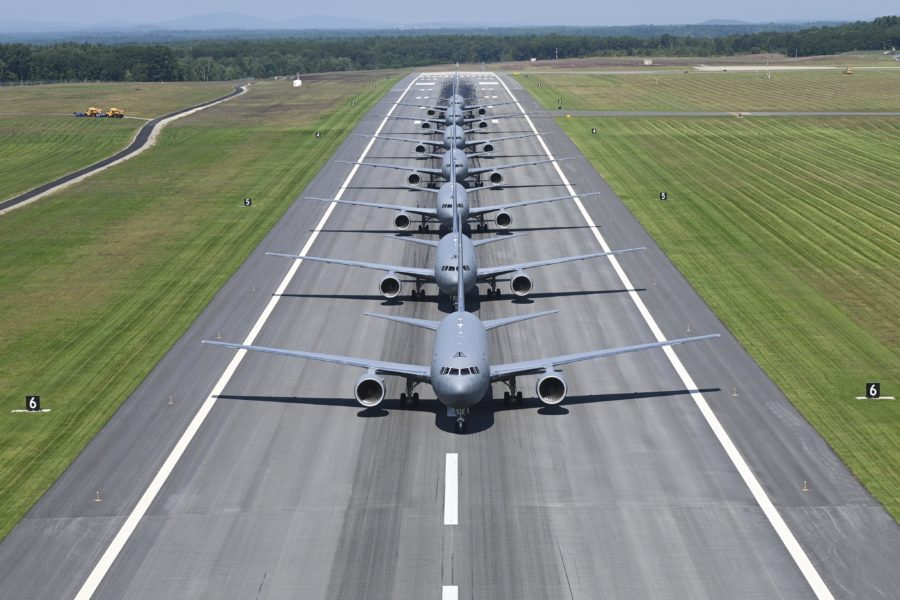Boeing has resumed deliveries of KC-46 tankers after a prolonged halt due to quality problems with fuel tanks, company president and chief executive officer David Calhoun said July 26 during a second quarter earnings call.
Yet company officials said supply chain problems continue to afflict Boeing programs, particularly defense-oriented ones, and full recovery will take some time.
“On the tanker, we have now completed rework on the production aircraft requiring it, and we have resumed deliveries to the Air Force,” Calhoun said.
Boeing first notified the Defense Contract Management Agency in January that there had been a process problem with KC-46 center wing fuel tanks, built by Triumph Aerostructures. The tank interiors had not been properly cleaned before being primed and delivered to Boeing. There was a possibility that the paint could flake off and clog fuel lines to the engines. The issue also affects the 767 freighter, on which the KC-46 is based.
At the time, Boeing determined there was no safety of flight issue, but deliveries of the jet were halted in March pending rework. The Air Force had only accepted one of 15 KC-46s planned for delivery this year before the problem emerged, and has taken none since. The service agreed with Boeing in January that there was no immediate risk to flight crews. Fuel filters installed in the jet are capable of detecting and catching paint flakes, and flight crews were instructed to watch for readings that would indicate paint flakes being caught in the filters.
An Air Force spokesperson was not immediately able to confirm that Boeing had resumed deliveries of the tanker, but the next two aircraft are slated to go to Travis Air Force Base, Calif. Boeing officials did not say whether they will be able to deliver the remaining 14 tankers required by the end of the year. Aviation Week reported July 13 that Air Mobility Command boss Gen. Mike Minihan said the delivery goal would be met.
Boeing officials also did not discuss progress on development and testing of the KC-46’s Remote Viewing System 2.0, which is supposed to conclude by the end of 2025. That effort calls for a complete changeout of the boom operator station behind the KC-46 cockpit, as well as the cameras used to provide the boom operator with three-dimensional views of the refueling operations at the tail of the airplane.
Despite the delay in deliveries, Boeing did not report any losses in the quarter on the KC-46, leaving the company’s total losses at a little more than $7 billion on the fixed-price program.
However, Boeing did record losses on three other fixed-price defense projects: the T-7A Advanced Trainer, at $189 million; the Navy’s MQ-25 refueling drone, at $68 million, and NASA’s commercial space crew transport, the Starliner, at $257 million.
“The T-7A impact was not due to any performance challenge within the quarter, [but] was more associated with our estimates for higher supply chain and production costs in the future,” Calhoun said. He noted, though, that “even with the cost growth, we’re hitting some key milestones on the program. The Air Force successfully completed its first flight of the T-7 [and] we’re heading toward the start of flight test in earnest.”
The Air Force conducted the first test flight of the T-7A with a USAF pilot on June 28. Four more production-representative airplanes are slated to comprise the test fleet, but the Government Accountability Office has warned that the service and Boeing have not finalized what the aircraft are to include ahead of low-rate and full-rate production, and this could lead to misunderstandings later.
Calhoun said Boeing is working through problems on its defense programs and has confidence after hitting milestones. He also claimed that the programs affected “will meet or beat the high performance standards of the warfighter.”
‘Given the fixed-price nature of some of our contracts, we’re very transparent about the financial impacts and we’re working to stabilize, to de-risk and mature them through development,” he added.
Expressing confidence in Boeing’s defense business, Calhoun also noted that analysis indicates a demand for 42,000 aircraft through 2043, “and with demand strong, the supply side of the system is beginning to settle down.”
There are still supply chain issues, however. Brian West, executive vice president and chief financial officer, said “we continue to see operational impacts from labor instability and supply chain disruption and other programs that contributed to lower margins.” For the defense-side of the business in particular, West said the company is “focused on the path to high single digit margins in 2025, 2026.”
Calhoun said his workers and vendors are “still in an extremely supply-constrained world, everything they do is supply constrained. … My prediction is it’s going to be quite a while” before the situation changes.
“Everybody’s fighting for the next part,” he said. “I think that’s just this moment we’re in.”
